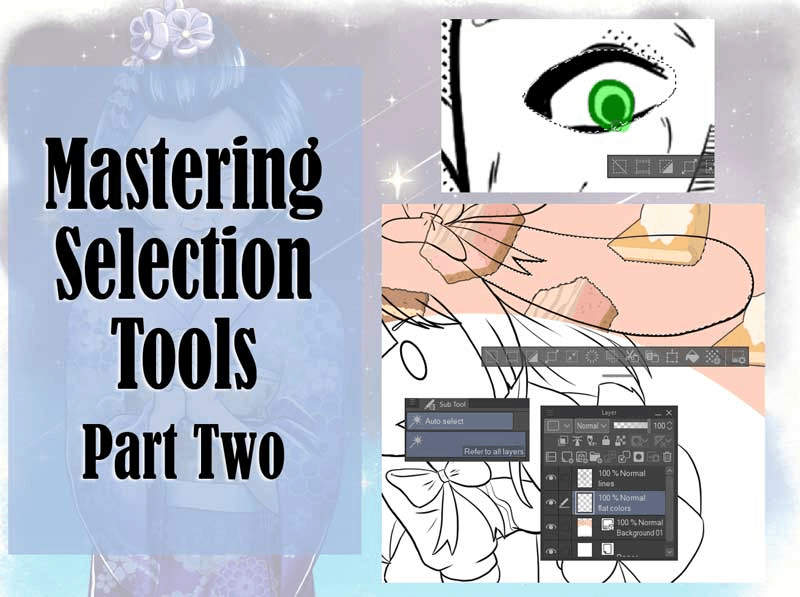[Video Tutorial] Creating a Starry Night City Scene
Introduction
Today we'll be going through the process of painting a scene of a pretty starry night sky in the city, the easy way. There's also a video available for this process so give it a watch if you can.
1. Setting up the city
I start with my city silhouette which I've opted to be a city by the water and honestly I just go in with different solid shapes. I use rectangles, triangle and circles to create different types of buildings. I vary the length and height to make them more interesting. They start looking like buildings after laying down a few of them. That said, I've looked at a lot of references over time and even just before starting the illustration in order for me to be able to just start out this way without a sketch.
Alternatively, you could always find some city silhoutte brushes.
The buildings that are further away are a much lighter colour to show distance. This is called atmospheric perspective. Just like you'll find that mountains in the distance will almost blend into the sky.
2. Base for the sky
After laying down my city, I start the sky by using the Gradient Tool. The tool is already on one of my favourite sky colour schemes which I've saved. For sky gradients, it's advisable making the horizon the lightest part of the colour scheme and then it gets darker further away.
Then I just adjust the colours a bit with the Hue/Saturation settings. If your gradients are looking a bit too straight, then use the blending brush to blend them out even more.
3. Establishing the Milky Way/star path
Using a watercolour brush which builds up, I start my milky way with a cloud formation. It should sort of looks like a column of smoke rising from the city. If you have a favourite smoke or cloud brush, you use that as well. I'm just using grey in order to see the volume of the cloud.
So I turned the blending mode to multiply and added a gradient on top which was a Vivid light mode in order to get this cloud to match my colour scheme. You can use whichever method seems easiest to you to change the colour.. So this path will be the darkest part of the sky.
4. Light and texture for the Milky Way
Then we expand on our milky way by adding the lights which are supposed to a stark contrast to the dark part we just made, I made a layer and used the Add Glow mode, then a different textured watercolour brush and the smooth watercolour brush to add the lights. The colour scheme all depends on the individual. As long as there's a big contrast between the two main colours.
Remember we're not only adding texture to the milky way but the entire sky as well just to break up the gradient and not make it seem generic.
5. Foundation for the stars
The next step is to add a foundation for the stars. This is fairly simple using the Tone Scraping airbrush.
6. Colouring the sky
Then we add more magic to our sky by adding different colours to our milky way. I chose to use a colour scheme of different blues and purples in this case. It makes the sky so much more interesting having different colours and even looking at photographs, you'll find how amazing the colour spectrum is when it comes to th night sky.
7. More stars!
After adding more colours with my watercolour and airbrush, I add more stars, this time going in with different brushes with varying sizes to make the stars more interesting. I just added an Add Glow layer and airbrushed over them with a different colour to give a bit of an interesting glow.
8. Adding colour to the city
Going back to our city, I turn the greys to different blues that match my colour scheme and use gradients to make the edges darker. It gives the building a feeling of being lit up by the lights below from the streets.
Then just use any soft circle brush for the lights at the bottom of the city and make them multicoloured.
To add quick lights to the buildings in the foreground, I just used the Dashed line tool and two rulers, one horizontal and one vertical to keep all the lines straight. In this instance, I was using the Special Ruler with the Parallel Line setting.
Then I added the finishing touches to the buildings by using my soft glitter brush for some soft lights and brightening the colours I used for the building gradients.
9. Adding the reflection
I then duplicated the sky and the building folders, flattened them and flipped them horizontally to make my reflections. I erased some of the city elements in the reflection and added a few ripples and darker shades to the water for variation.
Here's to the stars!
Thanks for joining me for this tutorial and I'm always open to questions at any of my social media accounts listed. I hope this was helpful and I'll probably be bringing more tips and tricks. o(〃^▽^〃)o
Here's a link to some useful brushes by one of my favourite illustrators.
























Comment